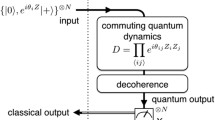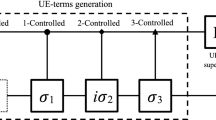Abstract
We have shown that any two quantum systems on finite-dimensional Hilbert spaces are equivalent under local transformations. These transformations give rise to a gauge group that connects the hamiltonian operators associated with each quantum system. Different quantum systems are connected in such a way that studying one of them allows understanding the other. This result can be applied to the field of simulation of quantum systems, in order to mimic more complicated quantum systems from another simulatable quantum system. Given that there is a bridge that allows to simulate a particular quantum system on these kind of Hilbert spaces using classical circuits we will provide a general scenario to extend this bridge to simulate the time evolution, via Schrödinger equation, of any of these quantum systems using classical circuits. This classical systems can be implemented and controlled more easily in the laboratory than the quantum systems.


Similar content being viewed by others
Change history
27 January 2023
A Correction to this paper has been published: https://doi.org/10.1007/s10773-023-05291-2
References
Feynman, R.P.: Simulation physics with computers. Int. J. Theor. Phys. 21, 467 (1982)
Georgescu, I.M., Ashhab, S., Nori, F.: Quantum simulation. Rev. Mod. Phys. 86, 153–185 (2014)
Lloyd, S.: Universal quantum simulators. Science 273(5278), 1073–1078 (1996)
Lamata, L., Parra-Rodriguez, A., Sanz, M., Solano, E.: Digital-analog quantum simulations with superconducting circuits. Adv. in Phys. X 3, 1457981 (2018)
Caruso, M., Fanchiotti, H., García Canal, C.A.: Equivalence between classical and quantum dynamics. Neutral kaons and electric circuits. Ann. Phys. 326(10), 2717–2736 (2011)
Caruso, M., Fanchiotti, H., García Canal, C.A., Mayosky, M., Veiga, A: The quantum CP-violating kaon system reproduced in the electronic laboratory. Proc. R. Soc. A. 472, 20160615 (2016)
Varadarajan, V.S.: Formal reduction theory of meromorphic differential equations: A group theoretic view. Pac. J. Math. 109(1), 1–80 (1986)
Varadarajan, V.S.: Linear meromorphic differential equations: A modern point of view. Am. Math. Soc. 33, 1–42 (1996)
Varadarajan, V.S.: Vector bundles and connections in physics and mathematics: Some historical remarks. Trends Math, 502–541 (2003)
Mostafazadeh, A.: Quantum canonical transformations and exact solution of the Schrödinger equation. J. Math. Phys. 38, 3489–3496 (1997)
Mostafazadeh, A.: Time dependent diffeomorphisms as quantum canonical transformations and the time dependent harmonic oscillator. J. Phys. A 31, 6495–6503 (1998)
Mostafazadeh, A.: Geometric phases, symmetries of dynamical invariants, and exact solution of the Schrodinger equation. J. Phys. A 34, 6325–6338 (2001)
Magnus, W: On the exponential solution of differential equations for a linear operator. Comm. Pure Appl. Math. VII(4), 649–673 (1954)
Giles, B., Selinger, P.: Exact synthesis of multiqubit Clifford+T circuits. Phys. Rev. A 87, 032332 (2013)
Rosner, J.L.: . Am. J. Phys. 64(8), 982–985 (1996)
Arnold, V.I.: Ordinary differential equations. Springer (1992)
Arnold, V.I.: Geometrical Methods in the Theory of Ordinary Differential Equations. Springer (1980)
Balabanian, N., Bickart, T.A.T.A.: Linear Network Theory: Analysis, Properties, Design and Synthesis. Wiley (1969)
Carlin, H., Giordano, A.: Network Theory: An Introduction to Reciprocal and Nonreciprocal Circuits. Prentice Hall (1964)
Acknowledgments
We thank to FIDESOL for the support and recall also the anonymous readers for their constructive criticism to this work.
Author information
Authors and Affiliations
Corresponding author
Ethics declarations
Conflict of Interests
The author declares that there are no competing interests.
Additional information
Publisher’s Note
Springer Nature remains neutral with regard to jurisdictional claims in published maps and institutional affiliations.
Rights and permissions
Springer Nature or its licensor (e.g. a society or other partner) holds exclusive rights to this article under a publishing agreement with the author(s) or other rightsholder(s); author self-archiving of the accepted manuscript version of this article is solely governed by the terms of such publishing agreement and applicable law.
About this article
Cite this article
Caruso, M. Quantum Systems Simulatability Through Classical Networks. Int J Theor Phys 61, 30 (2022). https://doi.org/10.1007/s10773-022-05045-6
Received:
Accepted:
Published:
DOI: https://doi.org/10.1007/s10773-022-05045-6




